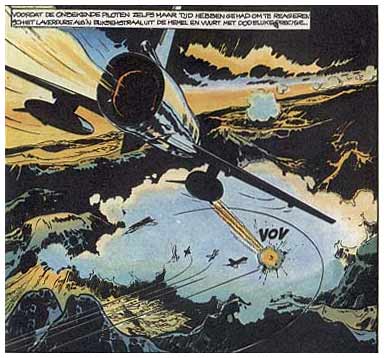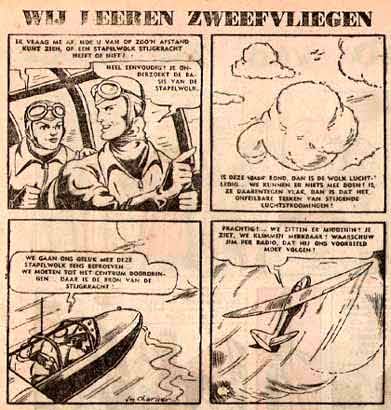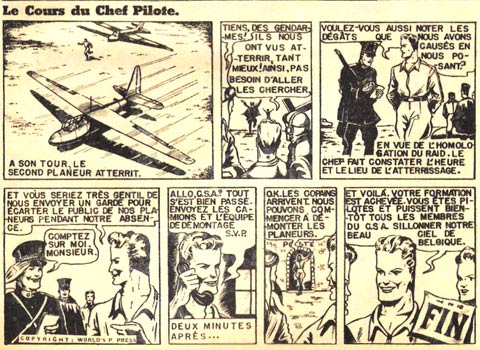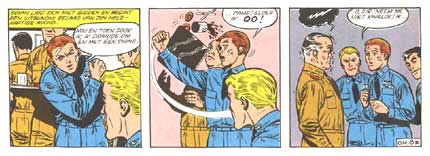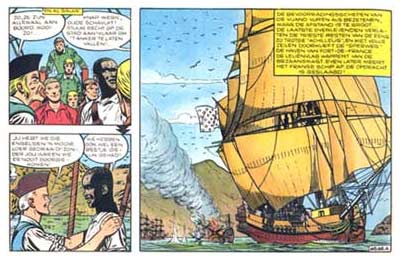'Tanguy et Laverdure', artwork by Jijé.
Jean-Michel Charlier was probably the most important writer of realistic adventure comics of the past century. What René Goscinny was for humorous comics, Charlier was for realistic comics. Although he earned fame from his writing abilities, Charlier started his career as an illustrator. He joined Spirou magazine in September 1944, where he did some aviation illustrations, as well as a comic about gliding, that he sometimes signed with Flettner.
Artwork for Spirou's aviation section by Jean-Michel Charlier.
Charlier got the chance to further showcase his love for airplanes two years later, when he took on writing the 'Buck Danny' series, illustrated by Victor Hubinon. Georges Troisfontaines, chief of the World's P. Press agency that provided the comic, had already written the first pages of 'Les Japs Attaquent' when Charlier took over. At first, Charlier also assisted Hubinon in the artwork, but after a few episodes, he focused solely on the scenarios.
'Le Cours du Chef Pilote' (Spirou #439, 12 September 1946).
Charlier always used recent events in 'Buck Danny', which often got him in trouble with the French censorship board of the 1950s. At the time, Charlier also worked a lot with other artists of the World Press agency, like Albert Weinberg, Eddy Paape, Dino Attanasio or Albert Uderzo. In 1951, Charlier co-launched the legendary 'Belles Histoires de l'Oncle Paul' series, where many young artists made their debut. Until 1954, Charlier wrote several of these historical stories, before handing over the writing to Octave Joly. In the 1950s, Charlier wrote numerous series in Spirou besides 'Buck Danny', like 'Kim Devil' (art Gérald Forton), some episodes of 'Jean Valhardi' and 'Marc Dacier' (both art Paape) and 'Thierry le Chevalier' (art Carlos Laffond). Another highlight of his work for Spirou is the scouting series 'La Patrouille des Castors', illustrated by MiTacq.
'Buck Danny', artwork by Victor Hubinon.
Along with Albert Uderzo and René Goscinny, Jean-Michel Charlier started the Édifrance agency, specializing in communication and comics. Charlier and Goscinny were also editors in chief of Pistolin magazine from 1955 to 1958, before starting Pilote magazine themselves in October 1959. Charlier launched three successful new series in Pilote, 'Tanguy and Laverdure' (with Uderzo and later Jijé), 'Barbe-Rouge' (with Hubinon) and 'Jacques le Gall' (with MiTacq). 1963 is also a highlight in Charlier's career. That year, he created the best European western comic, 'Blueberry', illustrated by Jean Giraud. In 1985, Charlier deepened the character of this cowboy, by exploiting his younger years in the spin-off 'La Jeunesse de Blueberry' (art by Colin Wilson).
'Barbe Rouge', artwork by Victor Hubinon.
While writing his several success series, Charlier wrote several lesser known comics. Most notable are the historical biographies he made with Victor Hubinon ('Surcouf', 'Jean Mermoz', 'Tarawa'), but he also made scenarios for Martial ('Alain et Christine' in Libre Junior, 'Rosine' in Pistolin), Raymond Poïvet ('Guy Lebleu' in Pilote), Aldoma Puig ('Brice Bolt' in Spirou), Christian Rossi ('Jim Cutlass') and Victor de la Fuente ('Los Gringos'). Charlier's scenarios stand out for their exciting and well documented storylines. Interesting about his work is his ability to illuminate dramatic stories with comical, slapstick-like events, like the clumsiness of Sonny Tuckson in 'Buck Danny' or the gluttony of Tapir in 'La Patrouille des Castors'. Suffice it to say that Charlier worked with virtually all great French comic artists of his day. All of his works remain a landmark of European comics.
Jean-Michel Charlier was an influence on Philippe Wurm.
'Blueberry', artwork by Jean Giraud.



